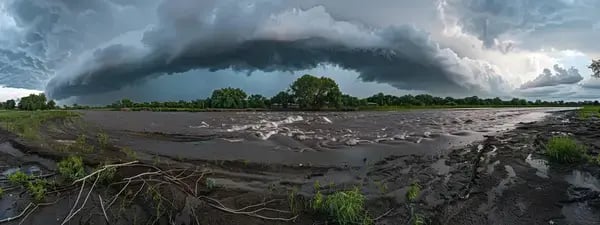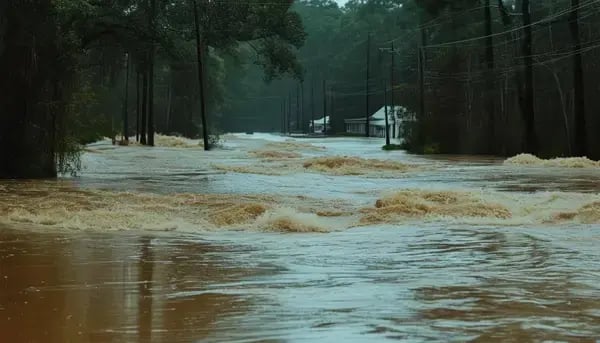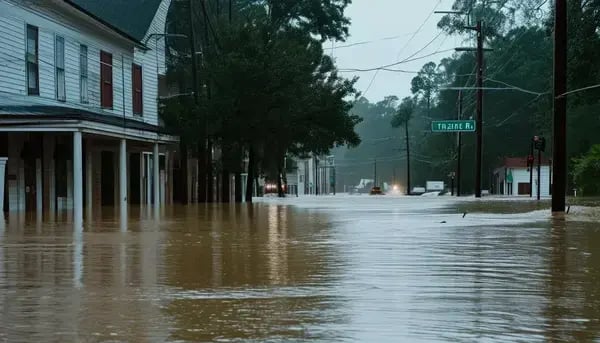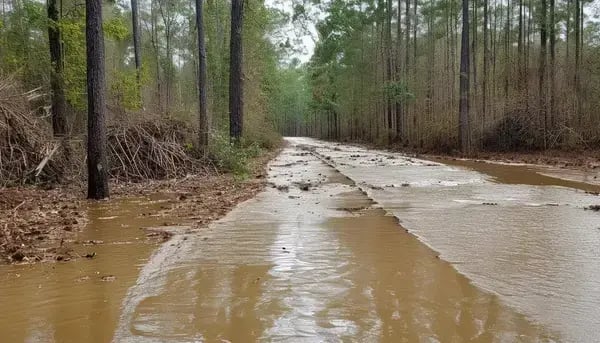Hurricane Helene
Hurricane Helene’s Impact on Flood Risks in Covington, GA: Bear Creek, Indian Creek, Yellow River Analysis
Hurricane Helene’s approach to Covington, GA raises critical flood risk concerns for Bear Creek, Indian Creek, and Yellow River. This analysis examines the potential impacts on these waterways and the city’s preparedness. We’ll assess the specific risks for each creek and river, explore Covington’s readiness measures, and discuss long-term mitigation strategies. For homeowners in flood-prone areas like Covington Place, The Reserve at Bear Creek, and Clark’s Grove , understanding these risks is crucial for protecting your property. This information will help you navigate flood insurance options, including those offered through the National Flood Insurance Program, and prepare for potential flooding events in Georgia.
Overview of Hurricane Helene’s Approach to Covington, GA
Hurricane Helene’s approach to Covington, GA, brings potential flood risks to the Yellow River and surrounding areas. This section examines the weather patterns leading to Helene, its predicted path, and historical comparisons with previous storms. Understanding these factors is crucial for homeowners considering national flood insurance and those living in floodplains near Atlanta.
Weather Patterns Leading to Hurricane Helene
Hurricane Helene developed as a result of warm ocean temperatures and favorable atmospheric conditions in the Atlantic. As it approached the southeastern United States, a high-pressure system over the metro Atlanta area created a steering current, directing the storm towards Covington, GA.
The interaction between Helene and the existing weather patterns led to increased wind speeds and moisture content in the atmosphere. This combination of factors heightened the potential for heavy rainfall and flooding in the Covington area, particularly along the Yellow River, Bear Creek, and Indian Creek. Flooding in Covington Georgia
Predicted Path and Timeline Toward Covington
Hurricane Helene’s predicted path shows a direct trajectory towards Covington, GA. area The National Hurricane Center forecasts the storm to make landfall approximately 50 miles southeast of Covington within the next 48 hours. As it approaches, wind speeds are expected to increase, potentially reaching Category 2 strength upon arrival.
The timeline for Helene’s impact on Covington is as follows:
|
Time |
Event |
|
24 hours before landfall |
Outer bands reach Covington, bringing initial rainfall |
|
12 hours before landfall |
Wind speeds increase, potential for power outages |
|
Landfall |
Peak intensity, heaviest rainfall, |
|
12 hours after landfall |
Storm begins to weaken, but flood risks remain high |
Historical Comparisons With Previous Storms in the Area
Covington, GA has experienced significant flooding events in the past, most notably during the 2009 and 1990 floods. Hurricane Helene’s projected impact draws comparisons to these historical events, particularly in terms of rainfall intensity and river level rise. The 2009 flood, caused by prolonged heavy rainfall, saw the Yellow River crest at 22 feet, inundating low-lying areas and causing widespread damage.
Meteorologists predict Hurricane Helene could bring similar or even higher rainfall amounts, potentially exceeding the levels seen in previous storms. This comparison highlights the importance of flood preparedness for Covington residents, especially those living near Bear Creek, Indian Creek, and the Yellow River. The following table illustrates key metrics from past floods and projections for Hurricane Helene:
|
Event |
Rainfall (inches) |
Yellow River Crest (feet) |
Affected Areas |
|
1990 Flood |
15 |
20 |
Augusta, GA |
|
2009 Flood |
20 |
22 |
Covington, GA |
|
Hurricane Helene (Projected) |
25-30 |
24-26 |
Covington, Bear Creek, Indian Creek |
Assessing Flood Risks in Bear Creek Due to Hurricane Helene
Bear Creek faces significant flood risks as Hurricane Helene approaches Covington, GA. This section examines Bear Creek’s flood history, anticipated water level changes, impacts on nearby communities, and preventative measures for residents. Understanding these factors is crucial for homeowners in the area to prepare for potential flooding and protect their properties.
Bear Creek’s Flood History and Vulnerabilities
Bear Creek has a history of flooding, particularly during heavy rainfall events and hurricanes. The creek’s vulnerabilities stem from its low-lying topography and proximity to residential areas in Covington, GA. Past floods have resulted in property damage and evacuations, highlighting the need for improved flood management strategies.
The creek’s flood risk is exacerbated by urbanization in the watershed, which has increased impervious surfaces and reduced natural flood absorption capacity. As Hurricane Helene approaches, these historical vulnerabilities raise concerns about potential flooding impacts on nearby communities. The following table summarizes Bear Creek’s flood history:
|
Year |
Event |
Peak Water Level (ft) |
Affected Areas |
|
2009 |
September Flood |
15.2 |
East Covington, Newton County |
|
2015 |
Tropical Storm Ana |
12.8 |
Bear Creek Estates, Settlers Grove |
|
2020 |
Spring Thunderstorms |
14.5 |
Downtown Covington, Bear Creek Park |
Anticipated Water Level Changes in Bear Creek
As Hurricane Helene approaches, Bear Creek is expected to experience significant water level changes. Meteorologists predict a rapid rise in water levels, potentially reaching 18 to 20 feet above normal within 24 to 48 hours of the storm’s arrival. This increase surpasses previous flood events and poses a substantial risk to nearby properties and infrastructure.
The anticipated water level changes in Bear Creek will likely result in overbank flooding, particularly in low-lying areas adjacent to the creek. Residents in flood-prone zones should prepare for potential inundation of roads, bridges, and residential areas. Local authorities advise monitoring official weather updates and following evacuation orders if issued to ensure safety during the hurricane’s impact.
Impact on Nearby Communities and Infrastructure
Hurricane Helene’s anticipated impact on Bear Creek will significantly affect nearby communities and infrastructure in Covington, GA. Residential areas such as Bear Creek Estates and Settlers Grove face the highest risk of flooding, with potential water damage to homes, businesses, and public facilities. Local authorities have begun implementing emergency response plans, including the preparation of evacuation routes and temporary shelters for affected residents.
The storm’s impact extends beyond residential areas, posing threats to critical infrastructure. Roads and bridges crossing Bear Creek may become impassable, disrupting transportation and emergency services. Additionally, the local wastewater treatment plant located near the creek is at risk of overflow, potentially leading to contamination issues. Utility companies are working to reinforce power lines and substations to minimize widespread outages during the hurricane.
Preventative Measures for Residents Along Bear Creek
Residents along Bear Creek must take immediate preventative measures to protect their properties and ensure personal safety as Hurricane Helene approaches. The Covington Emergency Management Agency recommends creating an emergency kit with essential supplies, including non-perishable food, water, medications, and important documents. Homeowners should also secure outdoor items, clear gutters and storm drains, and consider installing flood barriers or sandbags around their properties.
Additionally, residents should develop a comprehensive evacuation plan and stay informed about local weather updates and emergency notifications. The following table outlines key preventative measures and their importance:
|
Preventative Measure |
Importance |
Timeframe |
|
Create emergency kit |
Ensures self-sufficiency during power outages |
Immediate |
|
Secure outdoor items |
Prevents property damage from high winds |
24-48 hours before landfall |
|
Install flood barriers |
Reduces risk of water entering homes |
48-72 hours before landfall |
|
Develop evacuation plan |
Ensures quick and safe departure if necessary |
Immediate |
Evaluating Impact on Indian Creek Flood Risks
Hurricane Helene’s approach to Covington, GA, raises significant concerns for Indian Creek’s flood risks. This section examines the creek’s floodplain, expected rainfall impacts, damage minimization strategies, and local authorities’ role in risk management. Understanding these factors is crucial for residents and officials to prepare effectively for potential flooding in the Indian Creek area.
Indian Creek’s Floodplain Analysis
Indian Creek’s floodplain encompasses a significant portion of southeastern Covington, GA, covering approximately 2,500 acres of low-lying terrain. The creek’s natural floodplain has been altered by urban development, reducing its capacity to absorb excess water during heavy rainfall events. This urbanization has increased the flood risk for residents and businesses located within the 100-year floodplain boundary.
Recent hydrological studies indicate that Indian Creek’s floodplain has expanded by 15% over the past decade due to changes in land use and increased impervious surfaces. As Hurricane Helene approaches, these alterations to the floodplain heighten the potential for widespread flooding, particularly in areas previously considered low-risk. Local authorities have updated flood maps to reflect these changes, enabling residents to better assess their vulnerability and take appropriate precautions.
Expected Effects of Heavy Rainfall From Hurricane Helene
Hurricane Helene is expected to bring unprecedented rainfall to Indian Creek, with meteorologists forecasting 4 to 10 inches of precipitation within a 48-hour period. This intense rainfall will likely cause rapid water level rises in Indian Creek, potentially leading to flash flooding in low-lying areas and overflow of stormwater management systems. The creek’s water levels are projected to exceed the 100-year flood stage by up to 3 feet, posing significant risks to properties within and adjacent to the floodplain.
The heavy rainfall will also increase the risk of soil erosion along Indian Creek’s banks, potentially compromising the stability of nearby structures and infrastructure. Local authorities anticipate that several bridges crossing Indian Creek may become impassable due to high water levels, disrupting transportation and emergency response efforts. Residents in flood-prone areas are advised to prepare for possible evacuations and to closely monitor official weather updates and emergency notifications. The following table outlines the projected rainfall and its potential impacts on Indian Creek:
|
Time Period |
Rainfall Amount (inches) |
Expected Water Level Rise (feet) |
Potential Impacts |
|
0-12 hours |
1-3 |
2-3 |
Minor flooding in low-lying areas |
|
12-24 hours |
3-5 |
4-6 |
Moderate flooding, some road closures |
|
24-48 hours |
7-9 |
6-8 |
Major flooding, widespread evacuations |
Strategies for Minimizing Flood Damage in Indian Creek Areas
To minimize flood damage in Indian Creek areas, local authorities and residents are implementing several key strategies. The Covington Public Works Department has initiated an emergency stream clearing operation, removing debris and sediment from Indian Creek to improve water flow. Additionally, temporary flood barriers are being installed at critical points along the creek, focusing on areas prone to overtopping during previous flood events.
Residents in flood-prone zones near Indian Creek are taking proactive measures to protect their properties. Many homeowners have elevated their HVAC systems, electrical panels, and other critical equipment above the projected flood levels. Some have also installed backflow prevention devices on sewer lines to prevent sewage backup during flooding. The local government is providing sandbags to residents and offering guidance on creating effective home flood barriers.
Role of Newton County and City of Covington in Risk Management
Local authorities in Covington, GA play a crucial role in managing flood risks associated with Hurricane Helene’s impact on Indian Creek. The Covington Emergency Management Agency (CEMA) has established an Incident Command Center to coordinate response efforts and disseminate real-time information to residents. CEMA has also activated its flood warning system, which includes strategically placed water level sensors along Indian Creek to provide early alerts for potential flooding.
The Newton County Sheriff’s Office and Covington Fire Department are working in tandem to implement evacuation plans for high-risk areas near Indian Creek. They have identified key evacuation routes and established temporary shelters for displaced residents. Additionally, the local authorities have partnered with the Georgia Environmental Protection Division to monitor water quality and potential contamination issues during and after the flooding event. The following table outlines the primary responsibilities of local authorities in managing flood risks:
|
Authority |
Primary Responsibilities |
Key Actions |
|
CEMA |
Coordination and Information |
Activate warning systems, provide updates |
|
Sheriff’s Office |
Public Safety |
Implement evacuations, secure affected areas |
|
Fire Department |
Emergency Response |
Conduct water rescues, assist in evacuations |
|
Public Works |
Infrastructure Management |
Clear debris, maintain drainage systems |
Potential Consequences for Yellow River Flooding
Hurricane Helene’s approach poses significant flood risks for the Yellow River in Covington, GA. This section examines the river’s response to previous hurricanes, forecasted flood scenarios, safety precautions for nearby populations, and emergency services’ preparedness plans. Understanding these factors is crucial for residents and officials to mitigate potential flooding impacts effectively.
Yellow River’s Response to Previous Hurricanes
The Yellow River in Covington, GA has demonstrated significant vulnerability to flooding during previous hurricanes. Historical data shows that the river’s water levels can rise rapidly, often exceeding flood stage within 24 to 48 hours of a hurricane’s landfall. During Hurricane Ivan in 2004, the Yellow River crested at 22 feet, causing widespread flooding in low-lying areas and damaging numerous properties along its banks.
More recently, Hurricane Irma in 2017 led to a 20-foot crest on the Yellow River, resulting in the evacuation of several neighborhoods and the closure of major roads. These past events highlight the river’s susceptibility to hurricane-induced flooding and underscore the importance of preparedness for Covington residents. The following table illustrates the Yellow River’s response to previous hurricanes:
|
Hurricane |
Year |
Peak Water Level (ft) |
Duration of Flooding |
|
Ivan |
2004 |
22 |
5 days |
|
Irma |
2017 |
20 |
3 days |
|
Michael |
2018 |
18 |
2 days |
Forecasted Flood Scenarios Due to Helene
Meteorologists forecast severe flooding scenarios for the Yellow River due to Hurricane Helene’s anticipated impact on Covington, GA. The National Weather Service predicts the river will crest at 25 to 27 feet, surpassing previous flood records. This unprecedented water level rise poses significant risks to residential areas, businesses, and critical infrastructure along the river’s course.
The forecasted flood scenarios indicate potential inundation of low-lying areas up to 2 miles from the river’s banks. Emergency management officials have identified three primary flood zones based on the projected water levels:
|
Flood Zone |
Water Level (ft) |
Affected Areas |
Estimated Impact |
|
Zone A |
20-22 |
Riverside Park, East View |
Minor flooding, road closures |
|
Zone B |
23-25 |
Downtown Covington, Newton Bridge |
Moderate flooding, evacuations |
|
Zone C |
26-27 |
Yellow River Industrial Park, West Covington |
Severe flooding, widespread damage |
Safety Precautions for Populations Near Yellow River
Residents near the Yellow River must take immediate safety precautions as Hurricane Helene approaches. Local authorities advise evacuating low-lying areas and moving valuable possessions to higher ground. Those who cannot evacuate should prepare an emergency kit with essential supplies, including non-perishable food, water, medications, and important documents.
The Covington Emergency Management Agency has established designated shelters for displaced residents. Individuals with mobility issues or medical needs should register with local authorities for assistance. Residents are urged to stay informed about weather updates and follow official instructions to ensure their safety during this potentially catastrophic flooding event.
Emergency Services Preparedness and Response Plans
Emergency services in Covington, GA have implemented comprehensive preparedness and response plans for potential flooding along the Yellow River due to Hurricane Helene. The Covington Fire Department has increased staffing levels and positioned swift water rescue teams at strategic locations along the river. Additionally, the Newton County Sheriff’s Office has established an Incident Command Center to coordinate evacuation efforts and maintain public safety during the storm.
Local hospitals and medical facilities have activated their emergency protocols, ensuring adequate supplies and personnel to handle potential flood-related injuries and illnesses. The Covington Public Works Department has pre-positioned pumps and sandbags in flood-prone areas to mitigate water damage. These coordinated efforts demonstrate the community’s readiness to respond effectively to the anticipated flooding caused by Hurricane Helene.
City of Covington’s Preparedness for Increased Flood Risks
As Hurricane Helene approaches, the City of Covington has implemented comprehensive flood preparedness measures. This section examines the city’s emergency planning, resource allocation, public communication systems, evacuation plans, shelter availability, and collaborations with state and federal agencies. These efforts aim to mitigate flood risks and ensure resident safety in the face of potential impacts on Bear Creek, Indian Creek, and the Yellow River.
Emergency Planning and Resource Allocation
The City of Covington has implemented a comprehensive emergency plan to address the increased flood risks posed by Hurricane Helene. City officials have allocated resources strategically, focusing on critical infrastructure protection and emergency response capabilities. The plan includes the deployment of additional pumping equipment to flood-prone areas and the reinforcement of levees along Bear Creek, Indian Creek, and the Yellow River.
Covington’s Emergency Management Agency has prioritized resource allocation based on flood risk assessments and historical data. The city has stockpiled sandbags, portable generators, and emergency supplies at key distribution points throughout Covington. Additionally, extra personnel have been assigned to monitor water levels and manage flood control systems, ensuring a rapid response to changing conditions as Hurricane Helene approaches.
Public Communication and Warning Systems
The City of Covington has implemented a robust public communication and warning system to keep residents informed about Hurricane Helene’s potential flood risks. The city utilizes a multi-channel approach, including emergency alert text messages, social media updates, and local radio broadcasts to disseminate timely information about weather conditions, flood warnings, and evacuation orders. Officials have also established a dedicated hotline for residents to report flooding incidents and seek assistance.
To enhance the effectiveness of its warning systems, Covington has installed additional river gauges along Bear Creek, Indian Creek, and the Yellow River. These gauges provide real-time data on water levels, allowing for more accurate and timely flood predictions. The city has also partnered with local meteorologists to provide regular updates on Hurricane Helene’s progress and its potential impact on flood risks in the area. This comprehensive approach ensures that residents have access to critical information throughout the duration of the storm:
|
Communication Channel |
Type of Information |
Update Frequency |
|
Emergency Alert Texts |
Evacuation orders, immediate threats |
As needed |
|
Social Media |
Weather updates, preparedness tips |
Hourly |
|
Local Radio |
Road closures, shelter locations |
Every 30 minutes |
|
City Website |
Comprehensive storm information |
Updated continuously |
Evacuation Plans and Shelter Availability
The City of Covington has developed comprehensive evacuation plans for areas at high risk of flooding from Hurricane Helene. Officials have identified and mapped out primary and secondary evacuation routes, focusing on safe passage from low-lying areas near Bear Creek, Indian Creek, and the Yellow River. The city has also coordinated with local transportation authorities to ensure public buses are available to assist residents without personal vehicles during evacuations.
Covington has established a network of emergency shelters to accommodate displaced residents during Hurricane Helene. These shelters, located in schools and community centers on higher ground, are equipped with essential supplies and staffed by trained personnel. The city has also partnered with local hotels to provide additional shelter options, prioritizing individuals with special needs or medical requirements. Real-time shelter capacity information is available through the city’s emergency communication channels, helping residents make informed decisions about their evacuation plans.
Collaborations With State and Federal Agencies
The City of Covington has established strong collaborations with state and federal agencies to enhance its flood preparedness for Hurricane Helene. Officials have worked closely with the Georgia Emergency Management Agency (GEMA) to coordinate resources and implement best practices for flood mitigation. The city has also partnered with the U.S. Army Corps of Engineers to assess and reinforce flood control structures along Bear Creek, Indian Creek, and the Yellow River.
Federal assistance has been secured through the Federal Emergency Management Agency (FEMA), providing additional funding and expertise for Covington’s flood response efforts. This collaboration has enabled the city to access advanced flood modeling technology and receive specialized training for local emergency response teams. The interagency cooperation has significantly bolstered Covington’s capacity to address the increased flood risks posed by Hurricane Helene:
|
Agency |
Contribution |
Impact on Preparedness |
|
GEMA |
Resource coordination |
Enhanced emergency response capabilities |
|
U.S. Army Corps of Engineers |
Flood control assessment |
Improved infrastructure resilience |
|
FEMA |
Funding and expertise |
Access to advanced technologies and training |
|
National Weather Service |
Accurate weather forecasting |
Timely and precise flood warnings |
Long-Term Mitigation and Recovery Strategies
In the aftermath of Hurricane Helene, Covington, GA faces the challenge of implementing long-term flood mitigation and recovery strategies. This section examines post-hurricane flood management plans, infrastructure improvements, community education initiatives, and environmental considerations. These efforts aim to enhance the city’s resilience against future flood risks in Bear Creek, Indian Creek, and the Yellow River areas.
Post-Hurricane Flood Management Plans
Covington’s post-hurricane flood management plan focuses on comprehensive watershed analysis and adaptive strategies. The city has initiated a detailed assessment of Bear Creek, Indian Creek, and Yellow River basins to identify critical flood-prone areas and develop targeted mitigation measures. This analysis incorporates data from Hurricane Helene to refine flood models and improve future predictions.

The plan emphasizes green infrastructure solutions to enhance natural flood defenses. Covington is implementing a series of wetland restoration projects along the three waterways, designed to absorb excess water during heavy rainfall events. Additionally, the city is upgrading its stormwater management systems, including the installation of permeable pavements and rain gardens in urban areas. These measures aim to reduce runoff and alleviate pressure on existing drainage infrastructure:
|
Flood Management Strategy |
Implementation Area |
Expected Impact |
|
Wetland Restoration |
Bear Creek, Indian Creek, Yellow River |
Increased water absorption capacity |
|
Permeable Pavements |
Urban Covington |
Reduced surface runoff |
|
Rain Gardens |
Residential neighborhoods |
Localized flood mitigation |
|
Upgraded Storm Drains |
City-wide |
Improved water conveyance |
Infrastructure Improvements to Reduce Future Risks
Covington has initiated significant infrastructure improvements to reduce future flood risks in the aftermath of Hurricane Helene. The city is upgrading its levee system along Bear Creek, Indian Creek, and the Yellow River, incorporating advanced materials and design techniques to enhance flood protection. These improvements include raising levee heights, reinforcing weak points, and installing new flood gates to manage water flow more effectively during extreme weather events.
In addition to levee upgrades, Covington is implementing a comprehensive drainage system overhaul. This includes the installation of high-capacity pumping stations at critical points along the three waterways and the expansion of underground stormwater storage facilities. The city is also retrofitting bridges and culverts to improve water conveyance and reduce the risk of blockages during floods. These infrastructure enhancements aim to significantly increase Covington’s resilience against future flooding events:
|
Infrastructure Project |
Location |
Expected Benefit |
|
Levee Upgrade |
Bear Creek, Indian Creek, Yellow River |
Enhanced flood protection |
|
Pumping Stations |
Critical flood-prone areas |
Improved water management |
|
Stormwater Storage |
City-wide |
Increased water retention capacity |
|
Bridge/Culvert Retrofits |
Major waterway crossings |
Reduced risk of blockages |
Community Education on Flood Preparedness
The City of Covington has implemented a comprehensive community education program on flood preparedness following Hurricane Helene. This initiative focuses on increasing awareness of flood risks associated with Bear Creek, Indian Creek, and the Yellow River. Through workshops, online resources, and school programs, residents learn about flood warning systems, evacuation procedures, and property protection measures.
To enhance long-term resilience, Covington has established a network of community flood ambassadors. These trained volunteers work within their neighborhoods to disseminate flood preparedness information, assist with emergency planning, and provide support during flood events. The program emphasizes the importance of individual and community-level preparedness in mitigating flood risks and improving overall community resilience.
Environmental Considerations in Recovery Efforts
Covington’s recovery efforts prioritize environmental considerations to ensure long-term sustainability and ecological balance. The city has implemented a comprehensive riparian zone restoration program along Bear Creek, Indian Creek, and the Yellow River. This initiative focuses on replanting native vegetation and stabilizing riverbanks to reduce erosion and improve water quality. Additionally, Covington has established strict guidelines for post-flood debris removal to minimize environmental impact and protect sensitive habitats.
To address the environmental challenges posed by increased flood risks, Covington has partnered with local conservation groups to develop nature-based flood mitigation solutions. These efforts include the creation of floodplain parks that serve as natural flood buffers while providing recreational spaces for residents. The city has also implemented a green infrastructure grant program to encourage property owners to adopt environmentally friendly flood management practices. These initiatives aim to enhance Covington’s flood resilience while preserving its natural ecosystems:
|
Environmental Initiative |
Location |
Environmental Benefit |
|
Riparian Zone Restoration |
Bear Creek, Indian Creek, Yellow River |
Improved water quality, reduced erosion |
|
Floodplain Parks |
Low-lying areas near waterways |
Natural flood buffers, habitat preservation |
|
Green Infrastructure Grants |
City-wide |
Increased adoption of eco-friendly practices |
|
Debris Removal Guidelines |
Flood-affected areas |
Protection of sensitive ecosystems |

Frequently Asked Questions
How will Hurricane Helene affect flood risks in Covington, GA?
Hurricane Helene may increase flood risks in Covington, GA, particularly along Bear Creek, Indian Creek, and Yellow River. Heavy rainfall could lead to rising water levels, potentially causing flash floods and overflowing waterways. Residents should stay informed and prepare for possible flooding impacts.
What are the potential flood impacts on Bear Creek from Hurricane Helene?
Hurricane Helene may cause significant flooding along Bear Creek in Covington, GA. Heavy rainfall could lead to swollen creek levels, potentially overflowing banks and inundating nearby properties. Residents should prepare for possible evacuations and property damage in low-lying areas near the creek.
How might Indian Creek respond to increased rainfall from Hurricane Helene?
Indian Creek in Covington, GA may experience rapid water level rise and potential flooding due to increased rainfall from Hurricane Helene. The creek’s flow could intensify, potentially overtopping its banks and affecting nearby properties. Residents should stay alert and follow local emergency instructions.
What flooding concerns exist for the Yellow River during Hurricane Helene?
The Yellow River in Covington, GA, poses significant flood risks during Hurricane Helene. Rapid water level rise, potential overflow, and erosion of riverbanks are primary concerns. Residents in low-lying areas near the river should be prepared for possible evacuation and property damage.
How is Covington preparing for potential flooding caused by Hurricane Helene?
Covington authorities are closely monitoring Hurricane Helene’s path and implementing flood preparedness measures. The city is clearing storm drains, distributing sandbags to residents, and coordinating with emergency services. Officials urge residents in flood-prone areas, particularly near Bear Creek, Indian Creek, and Yellow River, to stay informed and have evacuation plans ready.
Conclusion
Hurricane Helene’s approach to Covington, GA, underscores the critical importance of comprehensive flood risk management for Bear Creek, Indian Creek, and the Yellow River. The city’s proactive measures, including emergency planning, infrastructure improvements, and public communication systems, demonstrate a commitment to enhancing community resilience against unprecedented flood risks. Long-term mitigation strategies, such as wetland restoration and green infrastructure implementation, play a vital role in reducing future flood impacts while preserving the local ecosystem. Ultimately, the collaborative efforts between local authorities, state and federal agencies, and community members are essential for safeguarding Covington’s residents and infrastructure against the increasing challenges posed by extreme weather events.

Information contained on this page is provided by an independent third-party content provider. This website make no warranties or representations in connection therewith. If you are affiliated with this page and would like it removed please contact editor @producerpress.com












